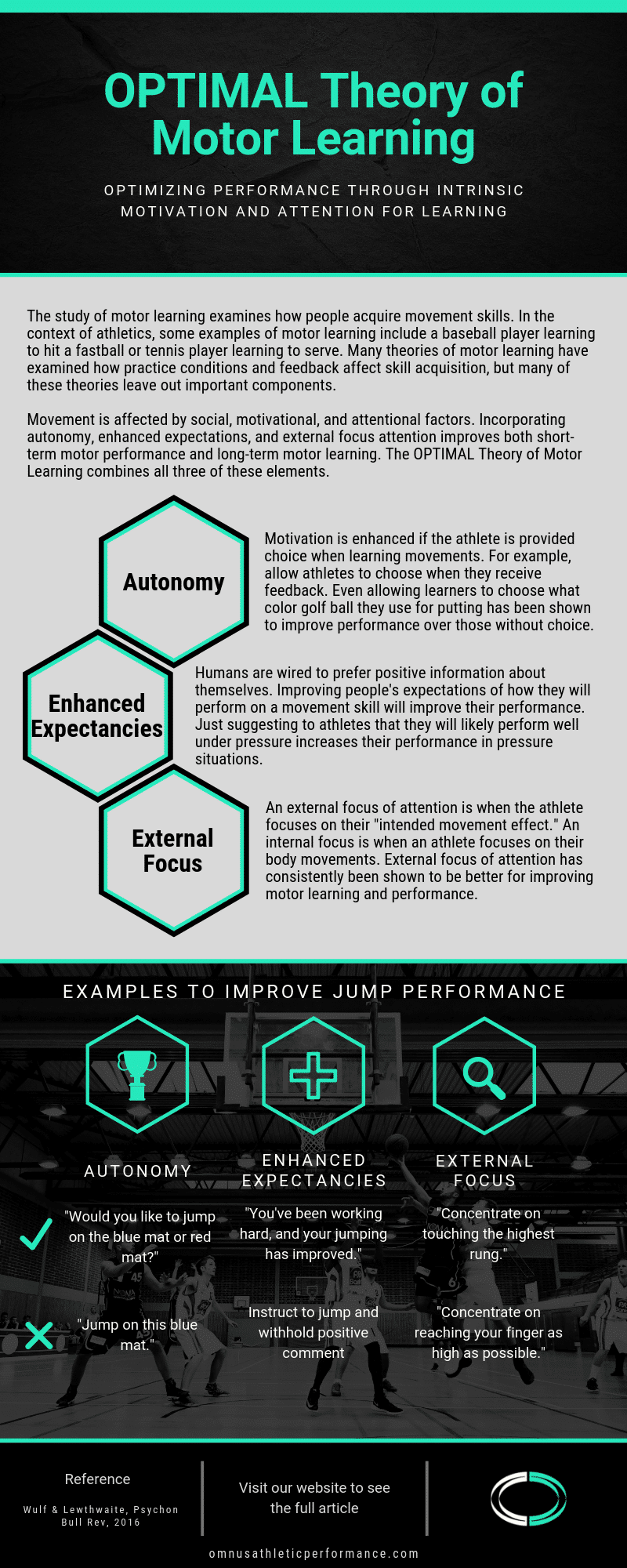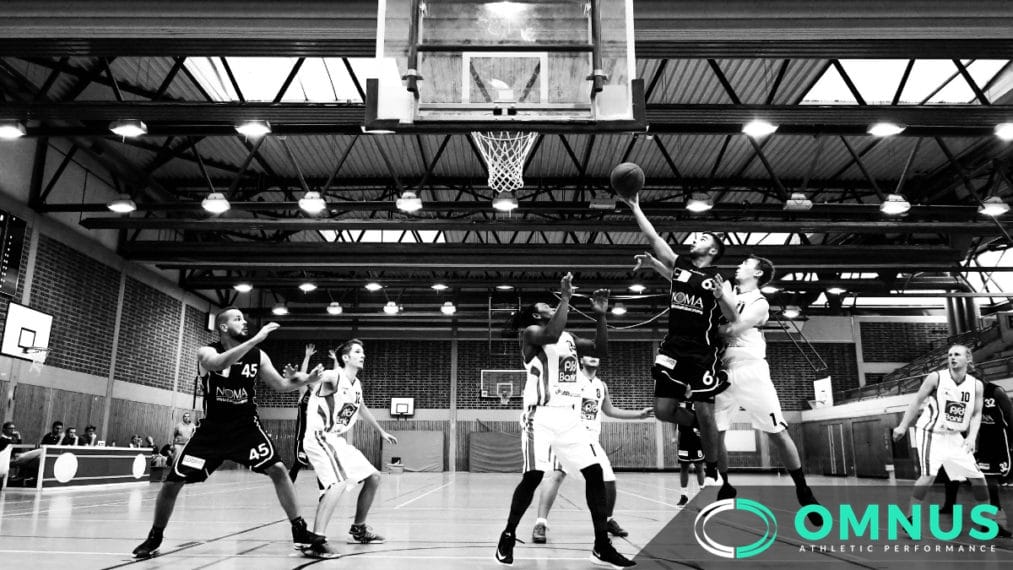What is the most effective way to teach athletes how to move? Many theories for motor learning focus on when feedback should be given, how practice should be organized, and what tasks should be performed. These theories are missing a huge component of motor learning.
Human movement is complex. Movement takes place in a social context. Other people can reassure an athlete to perform well or create pressure that hinders performance.
The athlete’s mindset must be considered too. Motor learning must be considered in the context of motivational and attentional influences on behavior. Does the athlete have a history of success when performing in pressure situations? Past success may lead to greater confidence when learning movement skills in these situations. Greater confidence may allow more effortless and automatic performance. What if the opposite were true? Would the athlete be overwhelmed with anxiety and perform poorly? Clearly, these factors can all play a role in motor learning.
The OPTIMAL Theory of Motor Learning (Wulf & Lewthwaite, 2016) seeks to incorporate these factors to optimize human movement. The theory proposes three conditions to optimize motivation and attentional focus to improve motor performance (short-term) and motor learning (long-term): autonomy, enhanced expectancies, external focus.
And these three conditions have an additive effect. The more you use, the better the motor learning results. Incorporating one is good. Two is better. Three is best.

Autonomy
Giving athletes choice — even if the choice seems inconsequential to the task — can influence learning. Motor learning is improved when autonomy is incorporated into practice conditions and when coaches use autonomy-supportive language. Telling an athlete to perform a movement task without any input can be detrimental to motor learning. Here are two examples:
- “Do 10 reps of this exercise.”
- “How does 10 reps sound for this exercise?”
The first statement is very controlling. You must do this many reps. You have no choice. Do this. The second statement is autonomy-supportive. It engages the athlete in the process. The athlete has a say in the task being performed.
The challenge is incorporating choices that still accomplish training goals and are agreeable for both the coach and athlete. Consider this scenario. The coach’s goal for a particular training session is to improve vertical jump performance. Asking the athlete, “Do you want to jump today?” may be inappropriate. A better choice may be, “I have programmed 3 jumping exercises that I think would benefit you. In what order would you like to perform those exercises?” The level of autonomy will depend on the relationship between the athlete and coach, but incorporating some form of autonomy has consistently shown to improve motor learning across a wide range of movement skills.
How to Incorporate Autonomy into Athletic Performance
Here are some examples of how to incorporate autonomy into daily practice.
- Ask athletes when they would like to receive feedback
- Ask athletes if/when they would like to watch a demonstration of the movement goal
- Allow athletes to choose the order in which they will perform prescribed drills
- Give athletes choice over task difficulty progressions and regressions
- Allow athletes to choose the color of the equipment they use, e.g., a red or blue golf ball
- Allow athletes to choose between different music playlists during training
Enhanced Expectancies
Expectations are intertwined with past experiences, self-efficacy, and motivation. Imagine a baseball player who has a history of failing in pressure situations. His coaches usually pinch hit for him in pressure situations now. What are his thoughts and expectations the next time he faces a pitcher with his team losing by a run and bases loaded? Does he freeze because he doubts his abilities? Does he believe he can learn to perform in these situations? These are all factors that will affect motor performance and learning.
Research has found that enhanced expectancies can improve motor learning. A couple different forms of enhanced expectancies include:
- Positive feedback
- Changing perceived task difficulty or definition of success
- Conceptions of ability
Positive feedback is feedback emphasizing successful performance and ignoring unsuccessful attempts. Athletes often know when they have performed something incorrectly. Consider a youth baseball player swinging and missing at several pitches during batting practice. The player knows the swings were unsuccessful. In fact, when athletes are allowed to choose the timing of feedback, they often choose to receive feedback after successful attempts. They want to capture that feeling of success. That feeling can improve motivation, which improves motor performance and learning.
Changing perceived task difficulty or definition of success can also enhance expectancies. Let’s use vertical jump performance as an example again. Athletes may perceive jumping as less difficult by telling them, “You’ll do well because of your hard work during training.” Simply changing the perception of the task can improve motivation and improve motor learning.
Changing the definition of success for a movement task can have a similar effect on motivation and enhanced expectancies. We’ll go back to the youth baseball player for this example. Maybe the coach’s definition of success is a batted ball that results in a line drive to the outfield. Achieving this outcome may be far outside the capabilities of the batter. The batter is discouraged by failed attempts, which negatively affects motivation and expectations. But, what if success were defined as making contact with the pitch. This definition may align better with the player’s motor abilities. The player’s motivation is improved, which improves motor learning.
Another way to enhance expectations is by changing a person’s conception of his or her abilities. Telling an athlete that athletic ability and movement skills are innate and cannot be changed will hinder performance. Framing movement skills as learned skills will improve performance. Here is an excerpt from Wulf and Lewthwaite (2016) that explains the possible mechanism for how perception of ability influences motor learning.
“In general, people who believe that (motor) abilities are relatively fixed (so-called entity theorists), tend to be more concerned with proving their ability, and they perceive errors or negative feedback as a threat to the self, because they reveal a limited capacity or lack of ability. In contrast, people who assume that abilities are changeable or malleable (so-called incremental theorists) tend to focus more on learning and improving their performance on a given task. They are less threatened by feedback indicating errors or poor performance, and they confront difficulties by increasing their effort.”
How to Incorporate Enhanced Expectancies into Athletic Performance
Here are some examples of how to incorporate enhanced expectancies into daily practice.
- Provide athletes with positive feedback after successful trials.
- Tell athletes they will perform well (yep, it can be that simple).
- Change the definition of success so the task is appropriately challenging
- Too easy a definition will not be motivating.
- Too difficult a definition will likely discourage participation.
- Frame motor learning as just that – learning.
- Learning is a process. Failure will happen, but skill can be improved.
External Focus of Attention
Attention refers to the athlete’s focus during a motor task. An external focus of attention is when the athlete focuses on the intended movement effect. An internal focus of attention is when the athlete focuses on body movements. An external focus of attention has consistently been shown to improve motor learning over an internal focus of attention across multiple studies.
Here is an example from the original study on external focus. Participants performed a balancing task on a ski-simulator. One group was instructed to focus on the pressure they exerted on the wheels of the ski-simulator, while the other group focused on their feet. The only difference in the experiment was the focus of attention, and the group using an external focus of attention (the wheels) outperformed the group using an internal focus of attention.
How to Incorporate External Focus of Attention into Athletic Performance
Here are some examples of how to incorporate an external focus of attention into daily practice.
- Push the ground away as quickly as you can (in regards to sprint acceleration)
- Touch the highest rung possible (when testing vertical jump on Vertec)
- Jump as far past the cone as possible (when performing broad jump)
Here are examples of an internal focus of attention which should be avoided.
- Extend your legs as quickly as possible (in regards to sprint acceleration)
- Reach your fingertips as high as possible (when testing vertical jump on Vertec)
- Extend your knee as quickly as possible (when performing broad jump)
Summary
Autonomy, enhanced expectancies, and external focus of attention are clearly important factors to optimize motor learning. The best part is that these motivational and attentional factors can be included in sport training at little to no cost. Coaches simply need to be aware of these concepts to incorporate them.
- Give athletes choice.
- Incorporate positive feedback, change perceptions of task difficulty and success, and emphasize to athletes that skills can be learned.
- Have athletes focus on the movement goal, not how their body moves.
Be sure to incorporate these three factors when working with your athletes. Comment below with your thoughts!

